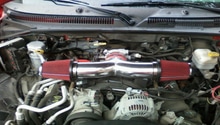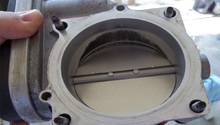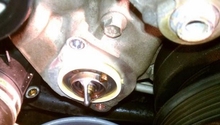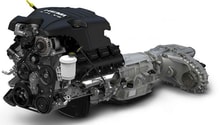Dodge Ram 2002-2008: The Ultimate EGR Valve Guide
The EGR (exhaust gas recirculation valve) on the Dodge Ram mixes exhaust gas with fresh air from the intake manifold to lower emissions. The EGR valve uses an electric motor controlled by the PCM to control the amount of exhaust gas entering the combustion chamber. When electrical or mechanical EGR valve failures occur, problems such as poor acceleration and reduced fuel economy can result.
This article applies to the Dodge Ram 3rd Generation (2002-2008)
The EGR valve is an electronic solenoid that moves a pintle, opening and closing a passageway for exhaust gas to flow through. The valve is bolted to the intake manifold/cylinder head and a metal hose connects it to the exhaust manifold/intake manifold. An electrical connector sends and receives signals to the PCM (powertrain control module) to control the valves movement for optimal emissions. When the engine is at moderate or heavy loads, the EGR valve will open to reduce the formation of oxides of nitrogen (a poisonous gas) from the combustion process. When a problem occurs, the EGR valve can become stuck open or closed, leading to poor fuel economy, rough idling, and engine knock.
Table of Contents
EGR Valve Overview
There are several different manufactures to purchase from when choosing an EGR valve. The factors in the decision include price, available warranty, user reviews, and reliability.
Mopar |
Doorman |
Standard Motor Products | |
|---|---|---|---|
Price |
$100-$120 | $20-$40 | $20-$40 |
Warranty |
24 Months/Unlimited Miles | Limited Lifetime | 3 Years/36,000 miles |
Rating |
Recommended | Recommended | Recommended |
Reliability |
High |
Medium | Medium |
Best Value: Doorman
Symptoms of a Bad EGR Valve
Stuck Closed
- Engine Knock: As the miles pass, carbon builds up at the EGR valve inlet and outlets. When this restriction becomes severe enough, engine knock can develop. This is most commonly heard as a tapping or pinging noise, since it is most noticeable during cruising and moderate throttle. This occurs because the engine may not realize the insufficient amount of exhaust gas entering combustion is not enough to combat engine knock. Fortunately, modern vehicles' computer systems are programmed with the logic to recognize this EGR flow problem and change engine parameters as well as set the associated diagnostic trouble code.
Featured Video: What Knock/Pinging/Detonation Sounds Like
Stuck Open
- Poor Idling, Stalling, and Engine No-Start: As the engine draws in fresh air, it's not expecting to have to compensate for the inert exhaust gas. No fuel is added to make up for the exhaust gas, and combustion cannot take place.
- Poor Acceleration: The air/fuel ratio is not optimized with the valve stuck open, leading to a decrease in engine output.
How to Install the EGR Valve
The EGR valve is in different locations for the 5.7 and 3.7/4.7 engines. On the 5.7, you will find it tucked between the air box and alternator. On the 3.7/4.7, you will find it on the back of the engine near the firewall. This one is substantially harder to reach than the 5.7's. There are a total of four bolts: one is on the connector attached to the valve.

Materials Needed
- 1/4" ratchet
- 3/8" ratchet
- 1/4" 8mm socket
- 10mm deep socket
- Swivel adapter
- Flat head screwdriver
- 3" extension
- 10mm wrench
- Shop rag
- Brake cleaner
- Emery cloth or fine grit sanpaper
- Penetrating oil
- Rubber gloves
- Safety glasses
Step 1 – Remove the resonator box (4.7/3.7 engines only)
The 4.7/3.7's EGR valve is located on the rear of the driver's side cylinder head, making it very hard to change without removing the resonator box.
Refer to Step 1 of the Related Article: How to Replace Ignition Coils and Spark Plugs for this procedure.
Step 2 – Remove the EGR valve
Begin removing the EGR valve from the 5.7 engine by locating it between the air box and alternator. At the top of the valve you will see a black electrical connector plug with a red tab. Push the red tab to the right to unlock it, and then squeeze the flexible tab on the connector plug while pulling it away from the valve.
Now, remove the exhaust hose from the EGR valve. There are two bolts with 8mm heads. If your hose appears rusted, soaking the bolts with a penetrating lubricant will reduce the chance of a bolt breaking.
Lastly, remove the two bolts with 10mm heads holding the valve to the intake manifold. It's best to use a deep socket to reach these bolts.
The only difference in removal for the 4.7/3.7 EGR valve is its location. Disconnect the electrical connector the same way as the 5.7's. When your are ready to remove the exhaust hose from the valve, use a 1/4" 8mm socket with a swivel and a 3" extension. You will not be able to see the two bolts with 10mm heads holding the valve to the cylinder head, and will need to remove them by feel. The EGR valve will then be ready for removal.

Figure 1. The location of the 5.7 engines EGR valve. 
Figure 2. The EGR valve off of the truck. 
Figure 3. The location of the EGR valve on the 4.7/3.7 engines. 
Figure 4. The 4.7/3.7 EGR valve removed.
Step 3 – Clean the gasket mating surfaces
This applies to the faces of the exhaust hose and intake manifold/cylinder head. Use a fine grit sandpaper or emery cloth along with brake cleaner and a rag to remove all of the carbon/gasket material from these surfaces.

Step 4 – Install the new EGR Valve
Slide the two bolts with 10mm heads through the valve, and then place the gasket over the bolts. Now guide the valve down into position against the cylinder head/intake manifold. Thread the bolts by hand first, and then tighten them down until snug. Place the new exhaust hose gasket onto the surface of the exhaust hose, and slide the two bolts with 8mm heads into the hose. Install the hose to the valve by hand first, and then tighten the bolts until snug. Push the electrical plug back into the EGR valve plug, and lock the plug with the red tab.
For the 4.7/3.7, you will need to re-install the resonator box.
To clear the check engine light, disconnect the negative battery cable with a 10mm wrench for five minutes.

Featured Video: How to Replace EGR Valve
Related Discussions
- EGR and Throttle Body Work with Pics - DodgeForum.com
- EGR Valve Replacement Trouble Codes - DodgeForum.com
- 5.7L Hemi EGR Valve Replacement - DodgeForum.com
- Symptoms of Bad EGR Valve - DodgeForum.com
- EGR Valve Removal - DodgeForum.com






